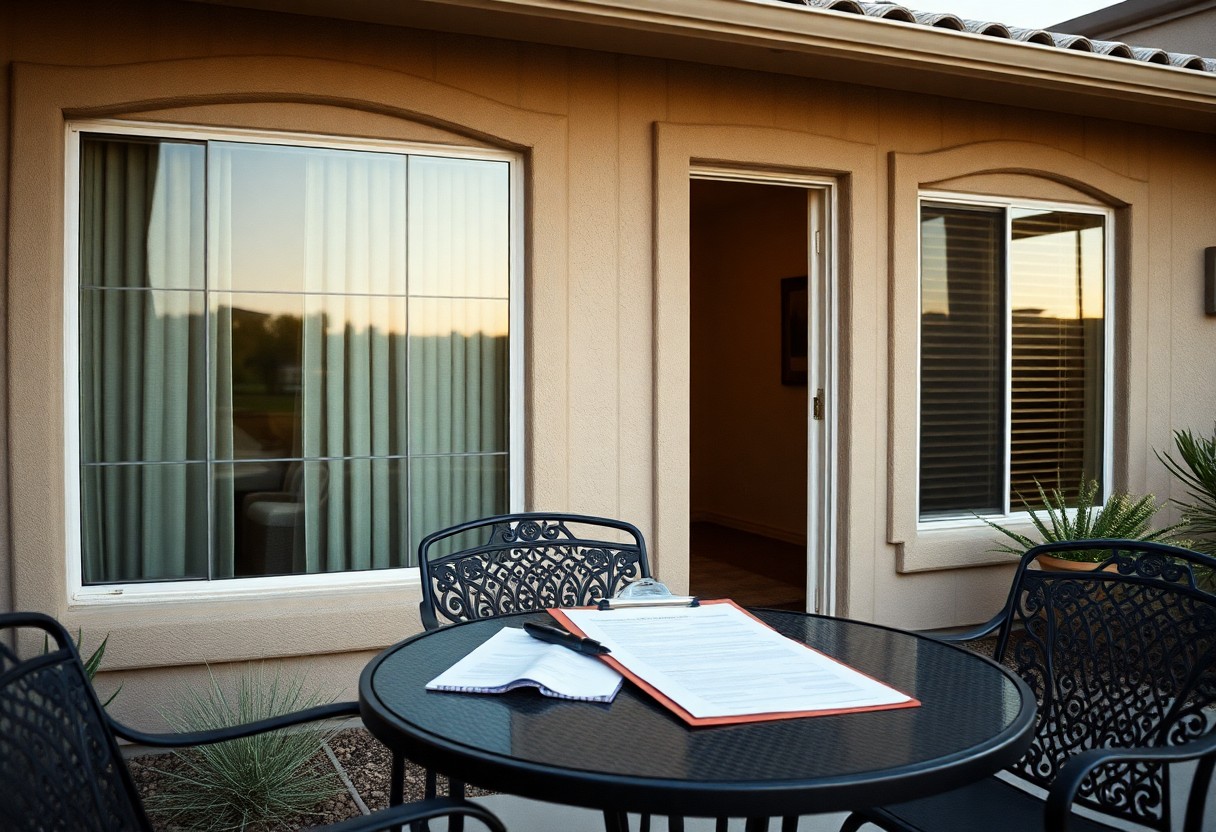Tinting your windows is more than just a style choice; it’s a smart investment that can enhance your Goodyear home’s energy efficiency and comfort. In this homeowner’s guide, you will discover key factors to consider when selecting the perfect window tint for your space. From understanding the different types of tints available to evaluating local regulations, you’ll learn how to make an informed decision that fits your needs and lifestyle. Let’s explore how the right window tint can transform your living environment and provide added privacy and protection.
Decoding the Spectrum: UV Protection vs. Aesthetics
Finding the perfect window tint involves understanding the balance between UV protection and aesthetics. While a darker tint can enhance your home’s curb appeal and give it a modern look, lighter tints may offer superior UV protection without compromising the brightness of your living space. The choice ultimately hinges on how you prioritize visuals against functionality, impacting both the atmosphere of your home and the well-being of your family.
The Science of Window Tinting and UV Rays
Window tint films are designed to block harmful UV rays, which can contribute to skin damage and fade your furniture. Most tints can block up to 99% of UV radiation, significantly reducing health risks while maintaining the view from your windows. This protective shield not only safeguards your interior but also helps in regulating indoor temperatures, leading to energy savings over time.
Balancing Beauty and Functionality in Tint Choices
Choosing window tints isn’t just about aesthetics; you have to weigh in their impact on your home’s comfort and energy efficiency. Opting for a film that provides a fashionable touch while still allowing ample natural light can create a pleasant ambiance. Additionally, consider tints that are versatile in design, allowing you to play with different intensities that complement your existing décor.
Achieving the right blend of beauty and functionality requires careful consideration of your personal style and practical needs. For instance, you might choose a reflective tint that enhances privacy during the day while still allowing some visibility at night. Meanwhile, a neutral-toned film can harmonize with different architectural styles, ensuring your home looks elegant without sacrificing the UV benefits. In Goodyear’s sunny climate, finding a window tint that preserves your interiors while enhancing your home’s aesthetic could be the key to achieving that perfect balance.
The Cost-Benefit Analysis: Long-Term Savings vs. Upfront Investment
Investing in window tint involves weighing immediate costs against potential long-term savings. Upfront expenses can vary, but they often yield significant returns through reduced energy bills, enhanced property value, and extended lifespan of furnishings. These benefits not only improve your living environment but also add to your home’s overall appeal, potentially offsetting the initial investment over time.
Evaluating Energy Efficiency and Utility Savings
Window tinting enhances your home’s energy efficiency by blocking a substantial percentage of UV rays and solar heat. You can experience utility savings averaging 30% on energy bills, especially in hotter months, making it a wise investment. Over time, these savings accumulate, often covering the cost of installation within a few years.
Factors Influencing Tint Costs: Quality vs. Brand
The cost of window tint can fluctuate based on various factors, including the quality of materials and the brand reputation. Premium films often come with warranties that guarantee performance for decades, giving you peace of mind. In contrast, cheaper options might save you money upfront but require replacements sooner than expected. This choice directly impacts your long-term satisfaction and financial savings.
- Material quality significantly affects durability and performance.
- Brand reputation is vital for ensuring reliability and longevity.
- Considering the intended use will influence your selection process.
- Installation complexity can vary, adding to costs if you need professionals.
- This impacts your overall cost-benefit ratio regarding investment.
In the market for window tint, recognizable brands often offer higher-quality products due to their extensive research and development efforts. For example, films that provide better insulation or glare reduction are frequently backed by warranties, underscoring their trustworthiness. While lesser-known brands might seem appealing due to lower prices, their performance may fall short, sometimes leading to higher costs over time. This becomes vital when considering long-term benefits versus initial expense.
- Researching product reviews can help you make an informed choice.
- Consider installation services, as experienced professionals can enhance product performance.
- Different regions may have specific tinting regulations influencing selection.
- Comparing similar brands ensures you’re getting the best value for quality.
- This leads to a financially sound decision that lasts for years.

Navigating Local Regulations: What Goodyear Homeowners Should Know
Before installing window tint, familiarize yourself with local regulations that govern the use of window treatments in Goodyear. These rules may dictate specific aspects of window tinting, such as the level of darkness allowed, reflective properties, and even color specifications. Understanding these regulations will not only ensure compliance but also save you from potential fines or mandated removal of tint that doesn’t meet local guidelines.
Understanding State and Local Tinting Laws
Arizona state laws outline specific limits for visible light transmission in automotive and residential window tinting. For residential properties, you can generally use non-reflective tint on the uppermost 4 inches of your windows, with darker tints prohibited to promote safety and neighborhood aesthetics. Researching these laws can protect your investment and enhance your home’s appeal.
Ensuring Compliance with Homeowners’ Association Guidelines
Homeowners’ associations (HOAs) in Goodyear often enforce strict guidelines regarding aesthetics, including window treatments. These regulations can vary significantly from community to community. Review your HOA’s rules to determine any restrictions on window tint properties like color, reflectivity, and even the types of materials permissible for installation. Approaching your HOA for pre-approval before making any tinting decisions not only keeps your home compliant but also fosters a cooperative relationship with your community.
Failure to comply with HOA guidelines can have consequences ranging from fines to the obligation to remove non-compliant tint. Some communities may require a specific level of reflectivity or even a color palette that aligns with the neighborhood’s overall aesthetic. Engaging with your HOA prior to installation can not only save you headaches later but may also provide insights into preferred vendors or recommended products that meet their standards. Understanding these requirements will keep your investment secure and in harmony with your surroundings.
Choosing the Right Tint for Your Home’s Architecture and Climate
Selecting the ideal window tint involves understanding how your home’s architecture and local climate influence your choice. The right tint can enhance your home’s aesthetic while providing energy efficiency, UV protection, and privacy. Consider both the style of your home and the varying weather conditions in Goodyear to make an informed decision. Matching your tint to these elements ensures that it complements your living space and meets your functional needs.
Geographic Considerations: Selecting Tint Based on Weather Patterns
Your geographical location significantly impacts the type of window tint you should choose. In Goodyear, where you experience plenty of sunshine and high temperatures, opting for a tint that reflects heat while allowing for natural light is advisable. Look for films with a high visible light transmission percentage combined with low solar heat gain coefficients to maintain a comfortable indoor temperature year-round.
Architectural Styles: How Your Home’s Design Impacts Tint Decisions
Your home’s architectural style plays a fundamental role in determining the right window tint. For contemporary designs, sleek, low-reflective tints often work well, enhancing the modern aesthetics. Conversely, traditional homes may benefit from softer tints that blend seamlessly with classic designs. Understanding how different tints complement architectural features—like large-picture windows or intricate framing—can guide your selection process.
For instance, if your home showcases large bay windows or extensive glass doors, consider using a lighter tinted film that still filters sunlight without compromising view quality. In contrast, homes with more intricate designs might require a more textured tint to match the architectural nuances. Additionally, darker tints may provide a bold statement for modern facades, while neutral shades can preserve the appearance of historic homes. Balancing aesthetic appeal and functionality is crucial for creating a cohesive look that enhances both beauty and comfort in your space.
Installation Insights: DIY vs. Professional Services
When deciding on window tint installation for your Goodyear home, you face a choice between DIY installation and hiring professional services. Weighing the pros and cons of each option can help you determine the best fit for your project goals and comfort level. DIY offers cost savings and flexibility, but professional installers provide expertise, efficiency, and peace of mind that can make the investment worthwhile.
Evaluating the Risks and Rewards of a DIY Approach
Taking the DIY route can be appealing, especially if you’re handy and want to save money. However, achieving a professional-looking result requires skill, precision, and the right tools. Improper application can lead to bubbles, tears, or misalignment that not only looks unsightly but can also result in more expenses to correct the errors.
Key Indicators for Hiring a Professional Installer
Several indicators can signal that hiring a professional is the wiser choice. If you lack experience with window installations, have large or uniquely shaped windows, or want to ensure a specific warranty on the tint, a professional installer can save you time and potential future costs. Additionally, industry expertise means better adherence to local regulations and cutting-edge application techniques that may be beyond the average homeowner’s skill set.
Professionals possess not only the right tools but also access to a variety of window films and the skills to assess which is best suited for your specific needs. They are familiar with common challenges, such as how to work with different types of glass or manage window edges to prevent peeling. Furthermore, professional installers often offer warranties on their work, ensuring that if issues arise later, you’re covered. This provides peace of mind and assurance that the job is done correctly the first time.
To wrap up
With these considerations in mind, you can confidently choose the right window tint for your Goodyear home. Assess your specific needs, including energy efficiency, UV protection, and privacy, to find the perfect tint solution. Take the time to research local regulations and consult with professional installers to ensure you achieve the desired look and functionality. By making informed choices, you can enhance your living environment while protecting your investment in your home.





